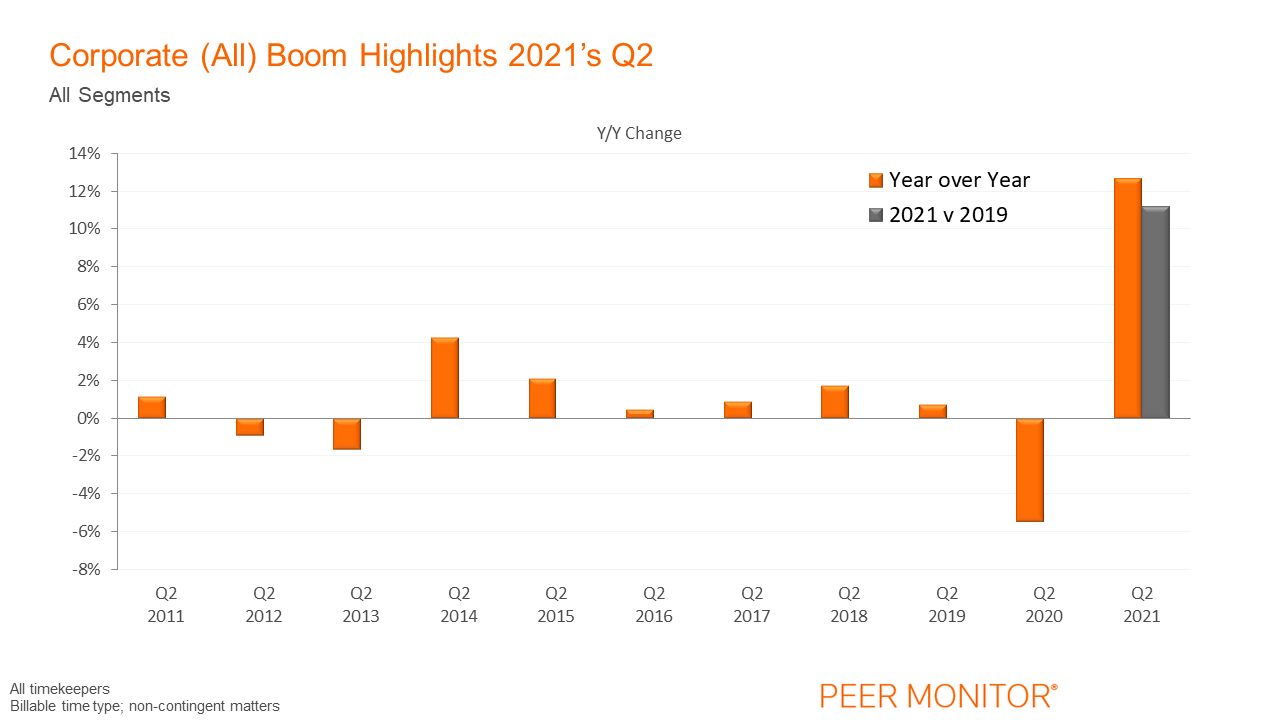The record-breaking performance by the Peer Monitor Index (PMI) in the 2nd quarter may have been driven in a large part by the hot Corporate practice area, including M&A activity. But can lawyers keep up?
In the second quarter of 2021, the Thomson Reuters Peer Monitor Index (PMI) hit an all-time high, rocketing up 22 points to a previously untouchable score of 84, its greatest showing of all time. While we have gone to great effort to point out the myriad underlying conditions that had to line up just right to achieve it, this is still a phenomenal result which deserves a deeper look.
At first glance the record-setting PMI can be credited to that ever-topical COVID-19 pandemic. For our purposes however, the pandemic served to create an exceptionally low baseline for compassion to current metrics. Unlike the great recession, this crisis has left the general health of the legal economy suppressed rather than damaged. As the suppression was removed the legal industry snapped back into full production.
So, there you have it: Litigation’s 7.7% demand growth and Real Estate’s 17.6% growth? All beneficiaries of a low baseline. Once measured against 2019’s 2nd quarter, this massive growth evaporates to -0.9% and 1.6%, respectively. Like a stage magician’s illusion, what you perceive is largely a function of where you’re looking.
Except, there is a problem. While at a first glance comparisons to the last “normal” year of 2019 show many practices flat or down, one practice stands out from the rest as deserving of the spotlight: corporate.

Although the corporate practice group saw smaller 2021 vs. 2020 growth than real estate, its 2021 vs 2020 growth was still impressive at 12.7%. Importantly, we see that this growth is no illusion in the above figure, with 2021 vs 2019 growth at just over 11%. Quickly, let’s contrast it to litigation’s performance during the same period.

In the above chart we can see that, in a Q2 2021 vs Q2 2020 matchup, corporate work is still well ahead of litigation in growth across all market segments. Litigation’s growth certainly appears respectable here as few firms would look askance at growing only 7.7%. Yet when we zoom out to our 2019 comparison, we see litigation is still below its “normal” baseline, having yet to recover to its pre-pandemic level.
Corporate on the other hand? Its growth appears unflappable, with Am Law 100 firms seeing 15% demand growth above 2019’s levels. Consider that litigation makes up 29% of the large law firm hours tracked and corporate lords over an additional quarter portion. This quarter’s metrics become more impressive in light of this, as corporate carries flagging practices like litigation across the finish line into Q3.
Except, once again, there is a problem.

This figure displays how practices with higher demand growth tend to have higher lawyer growth as they require an ever-increasing number of professionals to sate demand. The inverse can also be shown as practices which are shrinking tend to bleed lawyers as prospective recruits look to hotter practice areas and old hands move to where the grass is greener.
Mergers & acquisitions and general corporate are the two components of corporate (All) that in a year-to-date June 2021 vs 2020 comparison, were maintaining extremely high growth rates. Yet, they also go against the trend when it comes to recruiting. General corporate work is almost able to maintain the labor it already has despite its high practice growth. M&A has completely broken from the pack, hemorrhaging lawyers, down almost 3% YTD, even as it nears 15% practice demand growth.
The most likely interpretation? Corporate work is growing so fast that, in a labor market where new blood is a rare commodity, their lawyers are experiencing intense burnout. M&A especially is undergoing a sort of “too much of a good thing” phase, where it’s growing so fast that the lawyers simply cannot keep up and are dropping out faster than they can be replaced.
There are three potential ways this is likely to play out. The first is that corporate law firms turn down work they would have otherwise readily accepted because their operations have reached their breaking point. Secondly, firms feel reluctant to turn down work and the revenue that goes with it, and continue to take on work from an increasingly growing pool. The potential downside of this choice could be a further strain on resources resulting in reduced quality of work product – an outcome to be avoided for any lawyer. The third outcome is the most likely, as early indicators are signaling in its direction: full-time equivalent (FTE) growth increases as firms flood the market with recruiting dollars and larger salaries to attract the potential wave of associates expected to enter the market soon. In other words, the already hot legal labor market goes nuclear.
No matter which way this turns out, corporate’s Q2 2021 performance is already locked in. This was a quarter in which the practice area played the leading role in powering the overall legal market to an all-time high, a performance which in contrast to its co-stars’ opportunism, was all its own brilliance.






